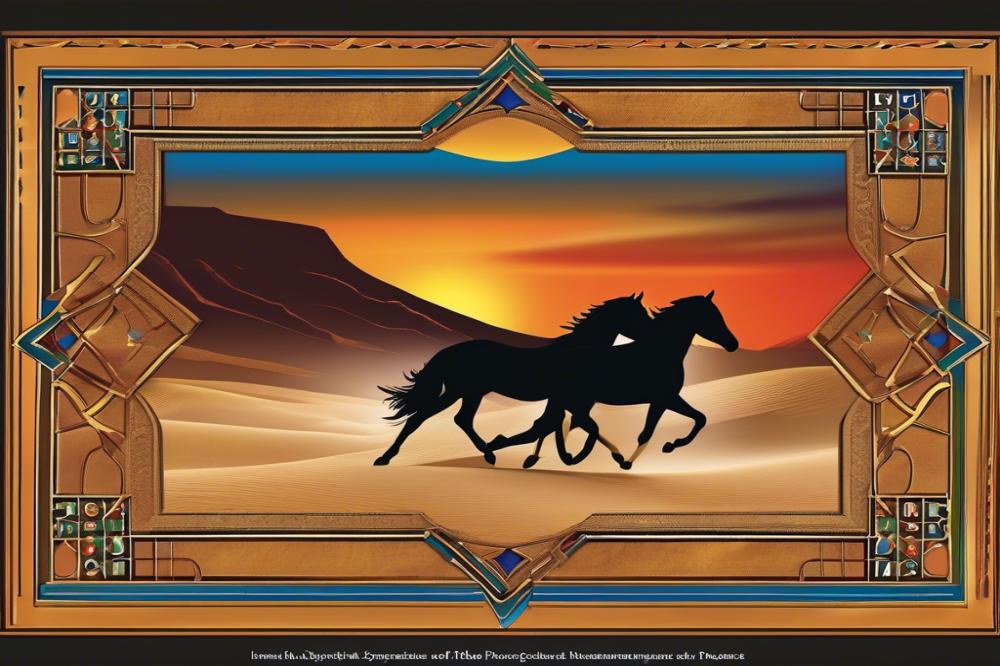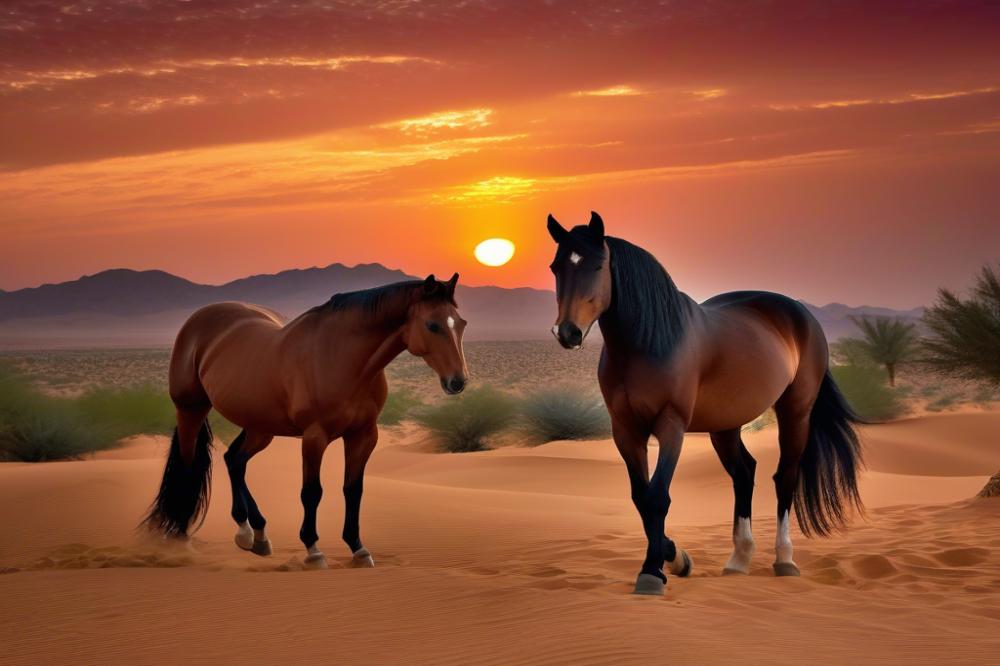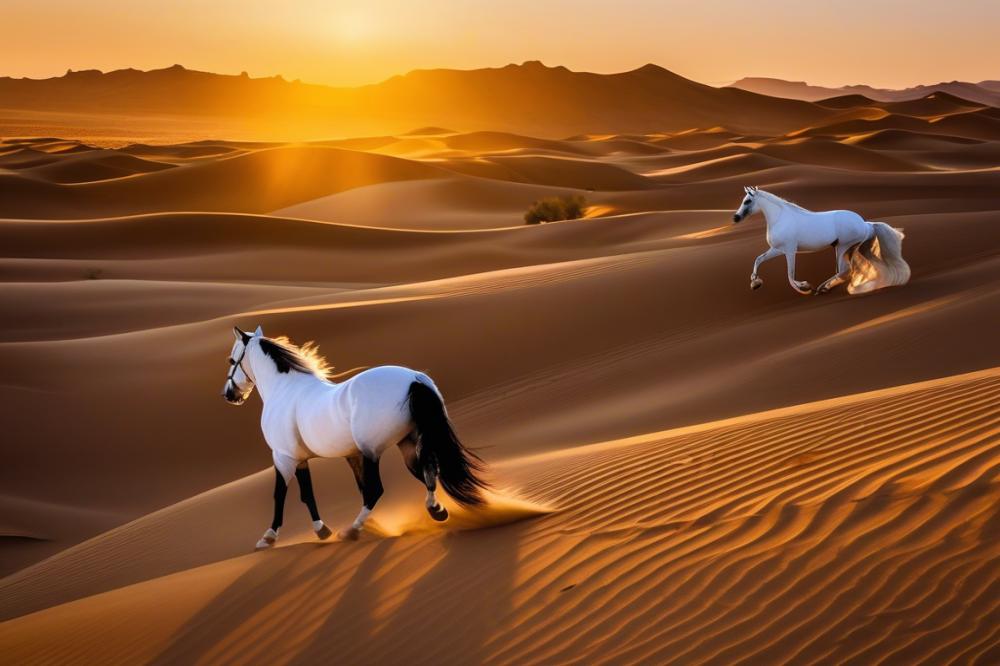Introduction
Horses have held a place of great importance in numerous cultures throughout history. Across the globe, they symbolize strength, endurance, and beauty. Many societies have woven their stories and traditions around these majestic animals. In the Arabian Peninsula, the bond between humans and horses goes even deeper. It is rooted in a rich history that intertwines with the lives of the Bedouin people.
In Bedouin culture, horses are not just animals. They represent nobility, status, and a connection to the land. For generations, these creatures have been companions in the harsh desert landscape. They have assisted in travel, trade, and warfare. The Arabians have unmatched grace and endurance, which makes them revered among equestrians. These animals play a critical role, both in daily life and as symbols of cultural identity.
Poetry and Music of this region often reflect the bond between the Bedouin people and their horses. Many poems capture the beauty of the ride through shifting sands. Songs echo with the sounds of galloping hooves, celebrating their strength and charm. This artistic expression provides a glimpse into the deep respect and admiration felt for these creatures. For the Bedouins, horses are more than mere beasts of burden; they are woven into the fabric of their stories and traditions.
Together, horses and the arts paint a vivid picture of life in the Arabian Peninsula. They encapsulate a unique cultural legacy that persists even in modern times. Understanding this connection allows us to appreciate the essence of the region’s heritage. The enduring relationship with these majestic creatures highlights their significance beyond just transportation. Indeed, they inspire some of the most beautiful poems and songs that echo across the desert landscape.
Arabian Horses in Bedouin culture

The Bedouin people have a rich and vibrant lifestyle shaped by their environment. Horses are central to Bedouin life, serving not just as animals but as essential partners in survival. Historically, these tribes roam the deserts. Each day, horses provide transportation, speed, and companionship. They are more than a means of travel; they connect Bedouins to their heritage and traditions.
Daily activities often revolve around these noble creatures. Each morning, the sound of hooves announces the start of tasks. Horses help gather resources, ranging from food to water. Their strength and endurance are vital, helping families navigate the harsh landscape. This relationship shows a deep bond built on trust and respect.
Special rituals and traditions also highlight the significance of horses. Celebrations often include races, showcasing the beauty and skill of both horse and rider. Events may draw entire communities together, fostering unity and pride. Storytelling around campfires often features tales of legendary steeds and heroic riders, bridging the past with present.
In ceremonial settings, horses play a crucial role. Weddings and festivals often feature them, symbolizing honor and dignity. They represent a lineage that values bravery and grace. For the Bedouins, horses embody more than just animals; they are a legacy passed down through generations.
Language reflects the importance of these creatures, with numerous terms dedicated to their various colors and traits. This vocabulary shows a profound appreciation for the animal. Each word carries a story, highlighting the bond shared between horse and rider.
Overall, horses are more than companions for the Bedouin people; they are a vital part of their identity. The connection between man and beast is evident in both daily life and spiritual practice. By riding into the sunset, Bedouins echo a timeless tradition that defines their existence.
Equestrian Symbolism in Arabian Poetry

Arabian poetry is rich with images and themes related to horses. Poets often use these majestic creatures to convey deep feelings. In many verses, equine imagery reflects strength, beauty, and nobility. Horses represent not just animals but also ideals, values, and emotions.
When poets write about horses, they often highlight their elegance and power. For instance, a horse galloping across the desert can symbolize freedom and grace. This imagery connects with the spirit of the Arabian people. The bond between horse and rider is portrayed as one of loyalty and mutual respect.
Famous poems clearly illustrate these themes. In several verses, poets describe the speed of horses in battle. Such descriptions create a vivid picture of warriors charging into action. The horse becomes an extension of the rider’s own strength. Through this bond, the veracity of bravery is often amplified.
Beauty is another significant motif found in poetry that features these animals. Descriptive language draws readers into a world where the coat of a horse shines like polished gold. Such details help establish the creature as a symbol of high status and nobility. This fascination with beauty often intertwines with themes of love, as well.
In works by renowned poets, distinctive features of breeds are often emphasized. The Arabian breed is known for its endurance and spirit. These attributes make the horse a fitting metaphor for enduring love or resilience in difficult times. One can see how the equestrian imagery serves a dual purpose: it glorifies the horse while also elevating human emotions.
Traditional Songs Celebrating Horses

Across the Arabian Peninsula, traditional songs highlight the rich relationship between people and horses. Many of these melodies reflect themes of love, pride, and bravery. Poetry and Music often intertwine, celebrating not just the beauty of the horse but also the bond between horse and rider. This connection is evident in songs that tell stories of historic races and legendary horses.
Cultural significance lies in how these songs embody the values of Bedouin life. Horses symbolize strength, freedom, and loyalty. Singing about them reinforces these ideals within the community. Through music, people remember their heritage and share tales of valor with younger generations. Such songs do more than entertain; they preserve cultural identity.
Examples of Traditional Songs and Their Meanings
Among the many traditional tunes, one notable example is “Al-Hawa al-Arabi.” This song speaks of the pure, mesmerizing beauty of a horse running across the desert. It captures the spirit of the Arabian landscape. Another popular piece is “Ya Foulana,” a love song where the horse becomes a metaphor for the lover’s spirit. Its lyrics highlight longing and connection, echoing the depth of emotion found in relationships.
“Sahnat al-Ashaq” showcases the admiration people have for their steeds. The lyrics paint a vivid picture of horses galloping with grace, emphasizing their elegance. As listeners engage with these songs, they not only enjoy the beat but also reflect on their own lives and the roles horses play in them. Each tune, with its distinct rhythm and story, offers insight into the cultural tapestry of this region.
In gatherings, these songs resonate with audiences, creating a shared experience that unites varied backgrounds. They spark conversations about tradition and heritage. The melodies and lyrics serve as a reminder of how deeply horses are woven into the fabric of society. As modernity approaches, these timeless songs continue to hold a special place in the hearts of many.
Arabian Literature and Horses

Historical context of horses in Arabian literature
Horses have played a significant role in the cultural history of the Arabian Peninsula. They symbolize strength, loyalty, and nobility. Desert tribes relied on these animals for transportation and warfare. This dependence shaped stories told around fires and in poetry. Many ancient poems celebrated the bond between humans and their steeds. As a result, horses became central figures in the region’s literary landscape.
Influence of horses on storytelling and folklore
In Arabian folklore, horses often represent more than mere beasts of burden. They embody the spirit of adventure and freedom. Stories frequently narrate epic quests where heroes ride off on their trusted mounts. These tales, passed down through generations, foster a deep appreciation for the animal. The imagery of galloping horses fills the pages of tales of victory and honor. Popular sayings link the qualities of horses to the virtues of bravery and loyalty in people.
Discussion of prominent literary works featuring Arabian Horses
Many poets have woven tales of horses into their verses. One such work is “The Mu’allaqat,” a collection of pre-Islamic poetry. Its authors often described horses with lyrical beauty, as if they were profound characters in human stories. Another notable figure is Al-Mutanabbi, who often touched on the themes of heroism and honor, invoking the image of the horse to enhance his messages.
Modern authors also draw inspiration from these majestic animals. In contemporary narratives, horses continue to symbolize hope and resilience. Their presence creates emotional depth and adds layers to the storytelling experience. The legacy of horses in literature remains vibrant, capturing the imagination of readers. The animal’s significance is deeply entrenched in Arab identity, making them timeless symbols of cultural pride.
Horse Racing and its Heritage
Horse racing holds a significant place in Arabian culture. Deeply rooted traditions celebrate the bond between horse and rider. For centuries, these majestic animals have represented strength, grace, and loyalty. Events centered around racing draw entire communities to witness the excitement and skills on display.
Many cultural celebrations revolve around races. Festivals often highlight the achievements of skilled trainers and jockeys. Families gather to cheer on their favorites. Vibrant festivities include music, food, and storytelling, all emphasizing the cherished role of horses in everyday life.
Modern racing has evolved, yet retains ties to its heritage. Arabian horses continue to be esteemed for their endurance and elegance. Their unique traits make them popular in racing circuits worldwide. Trainers invest time and resources to uphold traditional breeding practices, ensuring these creatures remain true to their origins.
Races also promote social interactions. Communities bond over shared passions and rivalries. Not only are these events entertaining, but they foster a sense of unity among spectators. Enthusiasts often discuss strategies, share experiences, and build lasting friendships.
Different types of races showcase various skills and approaches. Events vary from sprints to endurance challenges. Each race holds its own excitement and allure, attracting diverse audiences. Support for jockeys and their mounts creates a vibrant atmosphere filled with anticipation.
Today, the landscape of racing includes international competitions. Event organizers work to draw in global participants, enhancing cultural exchanges. This growth reflects the importance of horses in the Arabian Peninsula and beyond. People remain captivated by the thrill of competition, making it an enduring aspect of their heritage.
Reflection on the Significance of Horses in Arabian Culture
Horses hold a place of great reverence in the poetry and music of the Arabian Peninsula. They are not merely animals; they symbolize strength, beauty, and heritage. Poets and musicians have long celebrated these majestic creatures, weaving their stories deep into the fabric of Bedouin culture. Through verses and melodies, the emotional bond between humans and horses is illuminated. This connection reflects the values and experiences of the people who live in this vast and arid landscape.
The legacy of these animals endures in modern Arab society, shaping identities and traditions. Many contemporary artists still draw inspiration from the rich horse lore passed down through generations. This connection helps to foster a sense of community and pride among people in the region. Their imagery transcends time, emblazoned in the minds of those who cherish their significance.
Equestrian symbolism frequently appears in both traditional and modern art forms. When horses are celebrated in songs or verses, their strength becomes a metaphor for resilience. The struggles and triumphs of life are mirrored in the gallant spirit of these noble beings. It is easy to see why horses resonate so deeply with the hearts of many.
As time continues to march forward, the narratives surrounding these incredible animals remain strong. They act as living links to the ancestral past. In this way, horses not only preserve history but also cultivate a shared identity among people. The stories told through poetry and music enable newcomers and descendants alike to understand their cultural roots. Horses, therefore, are more than mere subjects of art; they are vessels carrying the tradition and soul of the Arabian Peninsula.



